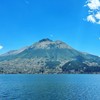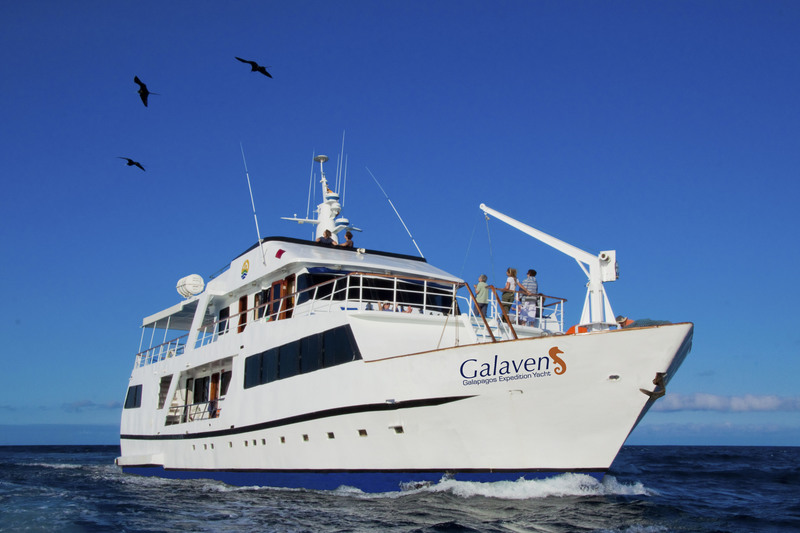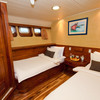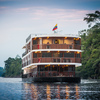Galaven
This 88-foot motorized, 20-passenger yacht offers high-polished wood trim and floors, a library with TV and DVD player, and sun deck with chaise lounges. The spacious dining area allows you to comfortably eat while marveling at the stunning views of the Galapagos archipelago.
Day 1 (Tuesday)
MORNING FLIGHT FROM QUITO OR GUAYAQUIL TO SAN CRISTOBAL (GALAPAGOS) & JACINTO GORDILLO BREEDING CENTER or PUERTO CHINO Assistance at the airport by our representative for your Galapagos flight. You will arrive at San Cristobal Island in the morning. After going through immigration and baggage claim you will be met by a Galaven staff member and transferred to the yacht. You’ll be shown to your cabin where you will have some time to settle in before lunch and a welcome briefing. The Jacinto Gordillo Breeding Center is a new visitor site in the northeast part of San Cristóbal Island and takes approximately one hour by road from Puerto Baquerizo Moreno. At the Breeding Center you will be able to admire the hatchling turtles, from their birth until they are 4 years old when the grown turtles are taken to their natural habitat.
In the afternoon you will visit Puerto Chino located 15,2 miles (24.5 km) away from Puerto Baquerizo Moreno and a few miles from the Breeding Center Cerro Colorado, this walk takes approximately 30 minutes to the beach.
Day 2 (Wednesday)
SANTA FE & SOUTH PLAZA ISLANDS.- Your morning visit is to Santa Fe Island (Barrington) which is home to the small picturesque bay and anchorage on the island’s northeast coast. The bay has two visitor trails: one leading to a scenic viewpoint atop a cliff, and the other spanning from a small beach to a tall prickly pear cactus forest.
In the afternoon, you will head to South Plaza Island. This small island with steep cliffs was formed by rising lava and is now covered by Opuntia cacti. It is also home to one of the largest sea lion colonies as well as colorful yellow and red land iguanas. The most characteristic plant is Sesuvium. During the rainy season, its color is a greenish to yellowish tone and in the dry season (end of June through January) a bright red.
Day 3 (Thursday)
SANTA CRUZ: FAUSTO LLERENA GIANT TORTOISES BREEDING CENTER & TWIN CRATERS Today you will visit Fausto Llerena Tortoise Breeding Center. This is home to tortoises ranging from 3-inches (new hatchlings) to 4-feet long. Subspecies of tortoises interact with one another and many of the older tortoises are accustomed to humans, stretching out their heads for a photo opportunity. The babies are kept here until they are about four years-old and strong enough to survive on their own.
The afternoon visit is to a site called Los Gemelos (Twin Craters). Los Gemelos wait for you at the end of a short hike. These sinkholes are often referred to as craters, though the term is only descriptive, not literal. They were created by the collapse of surface material in underground fissures and chambers. The endemic Scalesia forest surrounds the site where you may see vermillion flycatchers, short-eared owls, and finches.
Day 4 (Friday)
ISABELA: SIERRA NEGRA & WETLANDS, THE WALL OF TEARS OR BREEDING STATION The morning will consist of a visit to The Sierra Negra Volcano which is the largest basaltic caldera in the Galapagos at 9 x 10 km. The site offers impressive views and the opportunity to observe up to 7 species of finches and a rich display of vegetation. The north side of the caldera provides evidence of its most recent volcanic activity in 2005.
The afternoon visit will head to the Wetlands of Isabela Island, which are located just outside of Puerto Villamil. The Wetlands consist of lagoons, swamps, and mangroves and are home to a variety of unique bird species such as common stilts, whimbrels, white-cheeked pintails, and gallinules. The Wetlands can be visited on foot via a path through the swamps.
The Tortoise Breeding Station was created to protect animals in their first years of life from the threats of foreign species such as pigs and donkeys. Giant tortoise eggs are collected and brought to the center where they are hatched and kept for five years before being released to their natural environment.
Day 5 (Saturday)
ISABELA ISLAND: MORENO POINT & TAGUS COVE.- In the morning you will visit Moreno Point located southwest of Elizabeth Bay. Here a dry landing onto what was once flowing lava is possible. The lava has left craters in its wake which formed crystal tide pools. By looking into the pools, you can peer into another world as the marine life drifts by your window. In the brackish pools of this area, you may see pink flamingos, white-cheeked pintails, and common gallinules. If you look carefully into the pools, you may see white-tip reef sharks and some sea turtles.
In the afternoon, you will visit Tagus Cove on Isabela Island which is located across from Fernandina Island, close to the Bolivar Channel dividing the two islands. This spot has been frequented by ships since the 1800s, using the area as an anchorage site. Trails winding by Lake Darwin up to a ridge display wonderful views. Punta Tortuga, just north of Tagus Cove, is another lovely beach surrounded by mangroves.
Day 6 (Sunday)
FERNANDINA ISLAND - ESPINOSA POINT & ISABELA ISLAND - VICENTE ROCA POINT.- In the morning you will visit Fernandina Island. No foreign species have ever invaded this island, and therefore it is one of the world’s most pristine island ecosystems. Fernandina is the youngest island in the Galapagos. Access to this site is extremely restricted by the Galapagos National Park, and you will be one of those very lucky visitors. The volcano “La Cumbre” dominates the landscape with lava fields reaching the ocean.
Crossing the Bolivar Channel that divides Isabela and Fernandina Islands, you will land at Espinosa Point, and after walking past a colony of marine iguanas and a group of sea lions, you’ll reach the island’s highlight: The flightless cormorant nesting site. This area also provides a great opportunity to see the Galapagos hawk.
In the afternoon, you will head to Isabela Island. which is the largest in the archipelago. This seahorseshaped island is also one of the youngest and most volcanically active. The afternoon visit is at Vicente Roca Point. Comprised of two separate coves, this site is a large bay with spectacular sea life. Keep an eye out for seahorses, sea turtles, and the strange yet fascinating Mola mola (or sunfish).
Day 7 (Monday)
SANTIAGO – ESPUMILLA BEACH OR BUCCANEER COVE & BARTHOLOMEW ISLAND .- Your morning visit is to Espumilla Beach where marine iguanas lounge and the Sally Lightfoot crabs attract the hunting herons performing the dance of predator and prey right before your eyes. Snorkeling is highly recommended as you could find yourself face to face with an octopus, moray eel, shark and a variety of other species of tropical fish.
In the afternoon you will head for Bartholomew Island, home of the famous Pinnacle Rock. Bartholomew consists of an extinct volcano with a variety of red, orange, black and even green volcanic formations. You will take a trail of stairs to the summit of the volcano (about 30 or 40 minutes) where you will enjoy one of the best views of the islands! You will also visit a small, beautiful beach surrounded by the only vegetation found on this barren island. The beach is perfect for snorkeling where you may even see the Galapagos penguins.
Day 8 (Tuesday)
NORTH SEYMOUR ISLAND - DEPARTURE.- North Seymour. Here you will be able to see Galapagos sea lions, blue-footed boobies, and magnificent frigate birds which are abundant on North Seymour Island. The island was formed by a series of submarine lava containing layers of sediment that were uplifted by tectonic activity. The island is characterized by its arid vegetation zone.
After this final visit, you will be transferred to Baltra airport in time for your flight back to the mainland.
Day 1 (Friday)
MORNING FLIGHT FROM QUITO OR GUAYAQUIL TO BALTRA (GALAPAGOS) - EL CHATO.- Assistance at the airport by our representative for your Galapagos flight. You will arrive at Baltra Island in the morning. After passing through immigration and baggage claim, you will be met by the Galaven staff and transferred to the yacht. You will be shown to your cabin where you will have some time to settle in before lunch and a welcome briefing. Afterwards you will enjoy the El Chato reserve, which is divided into two areas: Caseta and Chato. The trail begins at Santa Rosa (13.7 miles / 22 km) from Puerto Ayora, with the Caseta route being the most challenging. The reserve allows visitors to observe giant tortoises in the wild during the dry season and is also a good place to spot short-eared owls, Darwin’s finches, yellow warblers, Galapagos rails and paint-billed crakes.
Day 2 (Saturday)
SANTA CRUZ: DRAGON HILL / BACHAS BEACH.- In the morning you will visit Dragon Hill on Santa Cruz. The visitors’ site at Dragon Hill is located in northwestern Santa Cruz Island and consists of a 1,600 m long trail that runs through three different environments. The beach is very rocky. At high tide it’s a nice place for snorkeling. At this visiting site you can find vegetation of the typical intertidal zone and dry zone.
The afternoon visit Bachas Beach, located on the north shore of Santa Cruz, Bachas is a swimming beach. One of the few remnants of the U.S. World War II presence in the Galapagos, a floating pier, can be seen here. You may see flamingos, Sally Lightfoot crabs, hermit crabs, black-necked stilts, and whimbrels. Sea turtles also nest on the beach.
Day 3 (Sunday)
FLOREANA ISLAND: POST OFFICE BAY & CORMORANT POINT OR DEVIL`S CROWN There are two visiting sites on Floreana Island. In the morning you will visit the famous Post Office Bay. You will land on the beach and head to a spot where 18th century whalers placed a wooden barrel for use as an unofficial mail box. The custom continues to this day with Galapagos visitors. So do not forget your postcards, and do not be surprised if the post card arrives to its destination before you even get home!
In the afternoon, you will head to Cormorant Point. Here you will enjoy a hike to a salt-water lagoon which is home to flamingos. You will also get to swim in the crystal clear waters of the Devil’s Crown. This extinct volcano peaks out of the waters just off of Floreana’s coast and offers a magnificent snorkeling experience.
Day 4 (Monday)
ESPAÑOLA ISLAND: SUAREZ POINT & GARDNER BAY.- Española Island is the southernmost island of the Galapagos and is the breeding site of nearly all of the waved albatrosses in the entire world. Española is densely populated with mockingbirds, bluefooted and Nazca boobies, Darwin finches, Galapagos doves, hawks, red and green marine iguanas, and colonies of sea lions. The morning trip will start with Suarez Point and a trail where you will have the chance to see bluefooted boobies, albatrosses and Nazca boobies. It is the breeding site of nearly all of the world’s 12,000 pairs of Waved Albatrosses. You will also visit a beautiful site on the ocean front where there is a cliff that the large albatrosses use as a launching pad! The landscape is great for photography and you will also have the chance to see the famous blowhole.
Day 5 (Tuesday)
SAN CRISTOBAL: INTERPRETATION CENTER & DEPARTURE.- In the morning you will visit The Interpretation Center which opened in 1998 as a phase of the project “Interpretation and Environment Education Project.” Visitors enjoy exhibitions on natural history, human history, and conservation. The conservation efforts represent the movement to protect the wildlife and natural environment through means of population and tourist control. The Interpretation Center has an outdoor stadium, audio-visual equipment, and meeting rooms.
After this final visit, you will be transferred to the San Cristobal airport in time for your flight back to the mainland.
Day 1 (Tuesday)
MORNING FLIGHT FROM QUITO OR GUAYAQUIL TO BALTRA (GALAPAGOS) - BLACK TURTLE COVE Assistance at the airport by our representative for your Galapagos flight. You will arrive at Baltra in the morning. After going through immigration and baggage claim, you will be met by a Galaven staff member and transferred to the yacht. You will be shown to your cabin where you will have some time to settle in before lunch and a welcome briefing. In the afternoon you will visit Black Turtle Cove in the northern part of Santa Cruz. This inlet is surrounded by mangroves and is only accessible by dinghy. The shallow cove is a haven for young marine life. Black-tip and white-tip reef sharks, sea turtles, and a variety of rays are often spotted here.
Day 2 (Wednesday)
GENOVESA: EL BARRANCO & DARWIN BAY Genovesa Island is located at the inner part of Darwin Bay. This area contains an abundance of frigate birds and other interesting seabirds. Behind the small beach filled with nesting areas for frigates, redfooted boobies, and swallow-tailed gulls are a number of tide pools. At high tide it is likely that the trail will be covered with water. Your morning visit is to El Barranco which is also known as Prince Phillip’s Steps, El Barranco’s steep and rocky path leads up to a high cliff-face. A marvelous view can be appreciated from here. This site is also home to Palo Santo vegetation as well as red-footed boobies, short-eared lava owls, Galapagos swallows, and Galapagos doves.
In the afternoon, you will head to Darwin Bay. This white-sand coral beach heads a half mile trail (0.5 miles / 0.75km) that winds through mangroves filled with land birds. Nazca boobies, red-footed boobies, and swallow- tailed gulls can be spotted here. Further down the path are tidal pools where sea lions swim playfully and at the end of the path there is a spectacular view off the cliff.
Day 3 (Thursday)
SANTIAGO – SULLIVAN BAY & RABIDA ISLAND The morning visit heads to Santiago Island – Sullivan Bay located on the southeast part of Santiago. This place is interesting for its geology because the area is covered by lava flows. This place has elevations in form of small volcanoes, formed by the lava flows.
In the afternoon you will visit Rabida Island (or Jervis) which is one of the most colorful and volcanically varied islands in the archipelago as well as a great snorkeling site. You will start on Rabida’s famous maroon/red sand beach and after an easy hike you will arrive to a stunning lookout point to enjoy the amazing landscapes. The island is a birdwatcher’s delight. Some of the rarest species are in abundance such as nine varieties of finches, large-billed flycatchers, Galapagos hawks and brown pelicans.
Day 4 (Friday)
SANTA CRUZ: FAUSTO LLERENA TORTOISE BREEDING CENTER & EL CHATO Today you will visit Fausto Llerena Tortoise Breeding Center. This is home to tortoises ranging from 3-inches (new hatchlings) to 4-feet long. Subspecies of tortoises interact with one another and many of the older tortoises are accustomed to humans, stretching out their heads for a photo opportunity. The babies are kept here until they are about four years-old and strong enough to survive on their own.
After this final visit, you will be transferred to the airport in time for your flight back to the mainland
Day 1 (Tuesday)
MORNING FLIGHT FROM QUITO OR GUAYAQUIL TO BALTRA (GALAPAGOS) - BLACK TURTLE COVE.- Assistance at the airport by our representative for your Galapagos flight. You will arrive at Baltra in the morning. After going through immigration and baggage claim, you will be met by a Galaven staff member and transferred to the yacht. You will be shown to your cabin where you will have some time to settle in before lunch and a welcome briefing. In the afternoon you will visit Black Turtle Cove in the northern part of Santa Cruz. This inlet is surrounded by mangroves and is only accessible by dinghy. The shallow cove is a haven for young marine life. Black-tip and white-tip reef sharks, sea turtles, and a variety of rays are often spotted here.
Day 2 (Wednesday)
GENOVESA: EL BARRANCO & DARWIN BAY.- Genovesa Island is located at the inner part of Darwin Bay. This area contains an abundance of frigate birds and other interesting seabirds. Behind the small beach filled with nesting areas for frigates, redfooted boobies, and swallow-tailed gulls are a number of tide pools. At high tide it is likely that the trail will be covered with water. Your morning visit is to El Barranco which is also known as Prince Phillip’s Steps, El Barranco’s steep and rocky path leads up to a high cliff-face. A marvelous view can be appreciated from here. This site is also home to Palo Santo vegetation as well as red-footed boobies, short-eared lava owls, Galapagos swallows, and Galapagos doves.
In the afternoon, you will head to Darwin Bay. This white-sand coral beach heads a half mile trail (0.5 miles / 0.75km) that winds through mangroves filled with land birds. Nazca boobies, red-footed boobies, and swallow- tailed gulls can be spotted here. Further down the path are tidal pools where sea lions swim playfully and at the end of the path there is a spectacular view off the cliff.
Day 3 (Thursday)
SANTIAGO – SULLIVAN BAY & RABIDA ISLAND .-The morning visit heads to Santiago Island – Sullivan Bay located on the southeast part of Santiago. This place is interesting for its geology because the area is covered by lava flows. This place has elevations in form of small volcanoes, formed by the lava flows.
In the afternoon you will visit Rabida Island (or Jervis) which is one of the most colorful and volcanically varied islands in the archipelago as well as a great snorkeling site. You will start on Rabida’s famous maroon/red sand beach and after an easy hike you will arrive to a stunning lookout point to enjoy the amazing landscapes. The island is a birdwatcher’s delight. Some of the rarest species are in abundance such as nine varieties of finches, large-billed flycatchers, Galapagos hawks and brown pelicans.
Day 4 (Friday)
SANTA CRUZ: FAUSTO LLERENA TORTOISE BREEDING CENTER & EL CHATO Today you will visit Fausto Llerena Tortoise Breeding Center. This is home to tortoises ranging from 3-inches (new hatchlings) to 4-feet long. Subspecies of tortoises interact with one another and many of the older tortoises are accustomed to humans, stretching out their heads for a photo opportunity. The babies are kept here until they are about four years-old and strong enough to survive on their own.
Afterwards you will enjoy the El Chato reserve, which is divided into two areas: Caseta and Chato. The trail begins at Santa Rosa (13.7 miles / 22 km) from Puerto Ayora, with the Caseta route being the most challenging. The reserve allows visitors to observe giant tortoises in the wild during the dry season and is also a good place to spot short-eared owls, Darwin’s finches, yellow warblers, Galapagos rails and paint-billed crakes.
Day 5 (Saturday)
SANTA CRUZ: DRAGON HILL / BACHAS BEACH.- In the morning you will visit Dragon Hill on Santa Cruz. The visitors’ site at Dragon Hill is located in northwestern Santa Cruz Island and consists of a 1,600 m long trail that runs through three different environments. The beach is very rocky. At high tide it’s a nice place for snorkeling. At this visiting site you can find vegetation of the typical intertidal zone and dry zone.
The afternoon visit Bachas Beach, located on the north shore of Santa Cruz, Bachas is a swimming beach. One of the few remnants of the U.S. World War II presence in the Galapagos, a floating pier, can be seen here. You may see flamingos, Sally Lightfoot crabs, hermit crabs, black-necked stilts, and whimbrels. Sea turtles also nest on the beach.
Day 6 (Sunday)
FLOREANA ISLAND: POST OFFICE BAY & CORMORANT POINT OR DEVIL`S CROWN There are two visiting sites on Floreana Island. In the morning you will visit the famous Post Office Bay. You will land on the beach and head to a spot where 18th century whalers placed a wooden barrel for use as an unofficial mail box. The custom continues to this day with Galapagos visitors. So do not forget your postcards, and do not be surprised if the post card arrives to its destination before you even get home!
In the afternoon, you will head to Cormorant Point. Here you will enjoy a hike to a salt-water lagoon which is home to flamingos. You will also get to swim in the crystal clear waters of the Devil’s Crown. This extinct volcano peaks out of the waters just off of Floreana’s coast and offers a magnificent snorkeling experience.
Day 7 (Monday)
ESPAÑOLA ISLAND: SUAREZ POINT & GARDNER BAY.- Española Island is the southernmost island of the Galapagos and is the breeding site of nearly all of the waved albatrosses in the entire world. Española is densely populated with mockingbirds, bluefooted and Nazca boobies, Darwin finches, Galapagos doves, hawks, red and green marine iguanas, and colonies of sea lions. The morning trip will start with Suarez Point and a trail where you will have the chance to see bluefooted boobies, albatrosses and Nazca boobies. It is the breeding site of nearly all of the world’s 12,000 pairs of Waved Albatrosses. You will also visit a beautiful site on the ocean front where there is a cliff that the large albatrosses use as a launching pad! The landscape is great for photography and you will also have the chance to see the famous blowhole.
In the afternoon, you will visit the spectacular Gardner Bay. After landing, you can walk across a lovely white- sand beach amongst a busy sea lion colony or dive into the water to swim with sea lion pups. You can also see curious mockingbirds on the beach.
Day 8 (Tuesday)
SAN CRISTOBAL: INTERPRETATION CENTER & DEPARTURE.- In the morning you will visit The Interpretation Center which opened in 1998 as a phase of the project “Interpretation and Environment Education Project.” Visitors enjoy exhibitions on natural history, human history, and conservation. The conservation efforts represent the movement to protect the wildlife and natural environment through means of population and tourist control. The Interpretation Center has an outdoor stadium, audio-visual equipment, and meeting rooms.
After this final visit, you will be transferred to the San Cristobal airport in time for your flight back to the mainland



Contact Us
You May Also Like
















